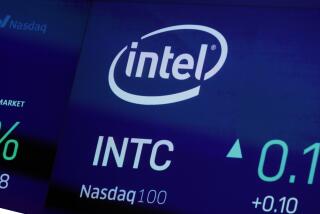Intel Deal May Not Lift Chip Supply
- Share via
Two U.S. semiconductor companies unveiled an alliance Wednesday designed to strengthen their positions against Japanese and domestic competitors. But many analysts warned that the deal between Intel Corp. and Micron Technology will do little, if anything, to ease the nation’s crippling shortage of computer memory chips.
The agreement calls for Micron to supply Intel with highly sought-after dynamic random access memory (DRAM) chips for the next three years. Intel, in turn, pledged to invest in Micron if the much-smaller company needs additional cash to expand its operations.
Some industry officials immediately described the venture as part of a new strategy by U.S. semiconductor producers to support each other and cope with the continuing challenge from Japanese and other East Asian chip makers. Some even suggested that the pact could ease the current shortage of DRAMs, which analysts estimate is running as high as 20% of supplies.
However, several independent industry experts and Wall Street analysts said the deal is unlikely to shake up the chip market.
“It’s a very good agreement on a company basis. But there is very little impact beyond that,” said Victor Didios of Dataquest, a San Jose research firm. “There is no new U.S.-grown technology involved and there’s no new manufacturing capacity created. As far as I can see it’s the same pot of chips that will be sold now by two companies, rather than one.”
Officials of the two companies said that beginning this summer, Intel will begin buying DRAMs from Micron and sell them worldwide under the Intel label. San Jose-based Intel is best known for making microprocessors, the “brains” of computer systems and other electronic devices. It wants to add DRAMs, which store bits of information for computer processing, to its product line to enhance its position as a supplier to electronics makers.
Intel also pledged to buy up to 600,000 shares of Micron stock, about 2% of its total, if the company needs additional cash. The investment, at a price of $19.375 a share, could amount to nearly $12 million.
Micron may well need the investment. Later this month, Micron is scheduled to break ground on a sprawling new chip-making plant that it is expected to double the Boise, Ida.-based company’s production capacity by the time of its completion early next year. The plant had been planned and approved long before the deal was struck with Intel.
Invented the Chips
Until the new plant is completed, the Intel-Micron agreement will involve only so-called 256K DRAMs, chips that handle up to 256,000 bits of information. However, the new plant will have production capacity for one megabit chips, a coming standard in semiconductors that currently is being mass-produced only in Japan. One megabit chips hold 1 million bits of information.
Intel, a 20-year-old firm with $1.9 billion in annual sales, invented the dynamic random access memory chip in the 1970s but abandoned production in 1985. Many other U.S. producers also were driven out of the DRAM business, largely at the hands of Japanese competitors. Micron, which had sales of $101 million in the first half of its current fiscal year, and Texas Instruments are the only U.S. chip firms still making memory chips.
The Intel-Micron agreement stems from strategy sessions held earlier this year in Silicon Valley to develop a response to the spiraling price increases and severe shortages of DRAMs linked to a trade pact between the United States and Japan in 1985.
In the agreement, Japan pledged to stop “dumping,” or selling chips below fair market value in the United States and in third-country markets. It also agreed to provide U.S. chip firms greater access to the Japanese market. Japan’s subsequent cutbacks in DRAM exports, however, translated into shortages that threaten to hamper U.S. computer manufacturers and other electronics companies.
Adds to Competitiveness
Robert Noyce, Intel’s vice chairman, and Joe Parkinson, chairman of Micron, told reporters at a news conference in Washington that the joint venture would assure Intel a steady source of chips that would enable the company to expand its marketing. At the same time, they said, the deal would provide Micron with the sales volume and capital it needs to justify the investment to boost production.
“We think this is the type of alliance that adds to the nation’s competitiveness in electronics,” he said.
But Wall Street analysts were less impressed. “It’s no big deal,” said Wendy Abramowitz, a technology specialist at Argus Research in New York. “The deal doesn’t increase the nation’s chip production capacity. It just changes who will be selling them. Right now, because of the shortage, Micron can sell all of its chips to whomever it wants.”
Rajiv Chaudhri, a semiconductor analyst at Goldman Sachs in New York, called the pact “more of a redirection of product. It doesn’t add to the overall supply.”
In stock trading Wednesday, Intel closed at $31.25 a share, up 25 cents, while Micron closed at $21, up $1.25.
Carla Lazzareschi reported from Los Angeles and Art Pine reported from Washington.






